
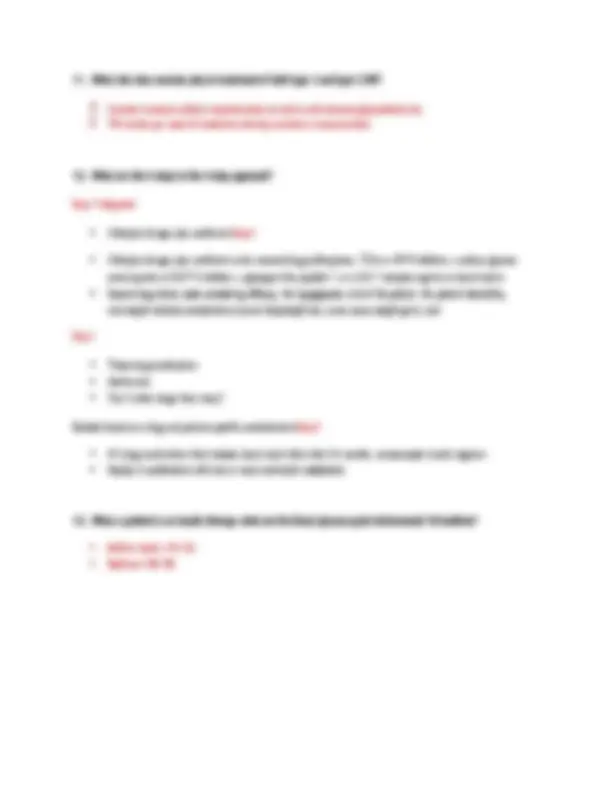
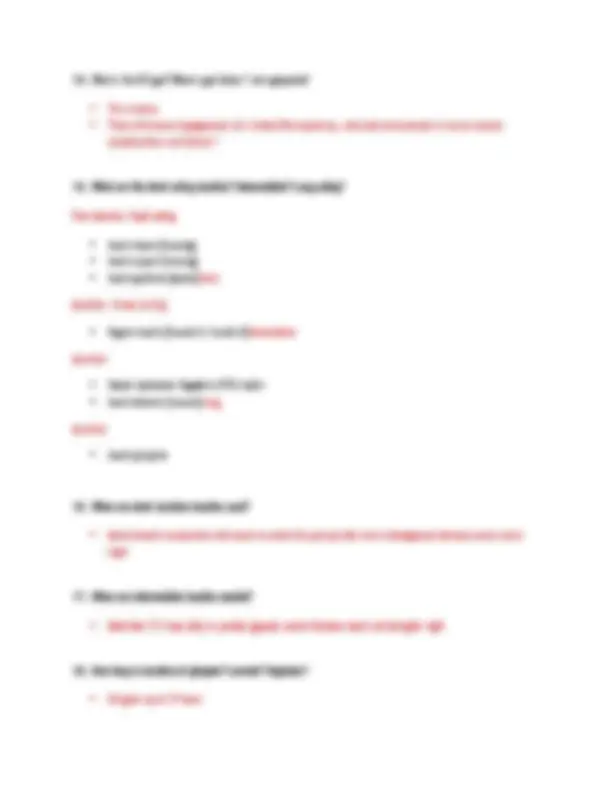
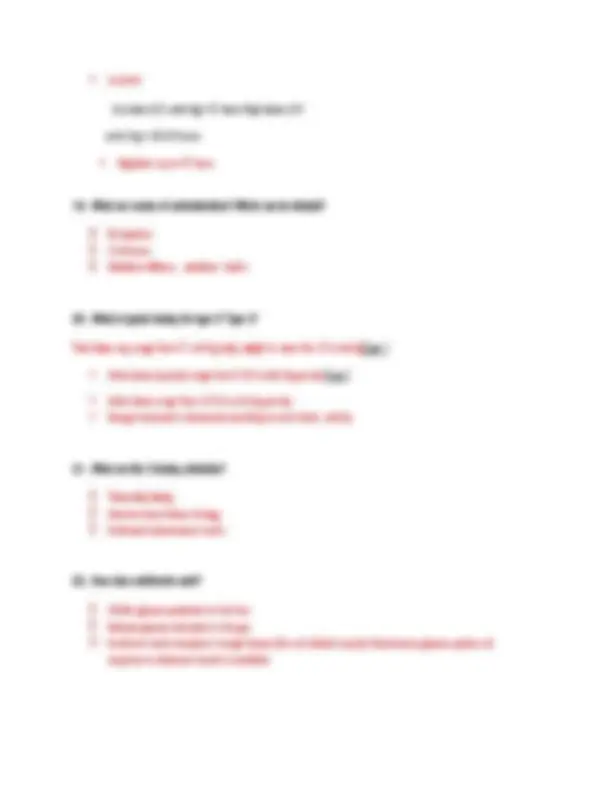
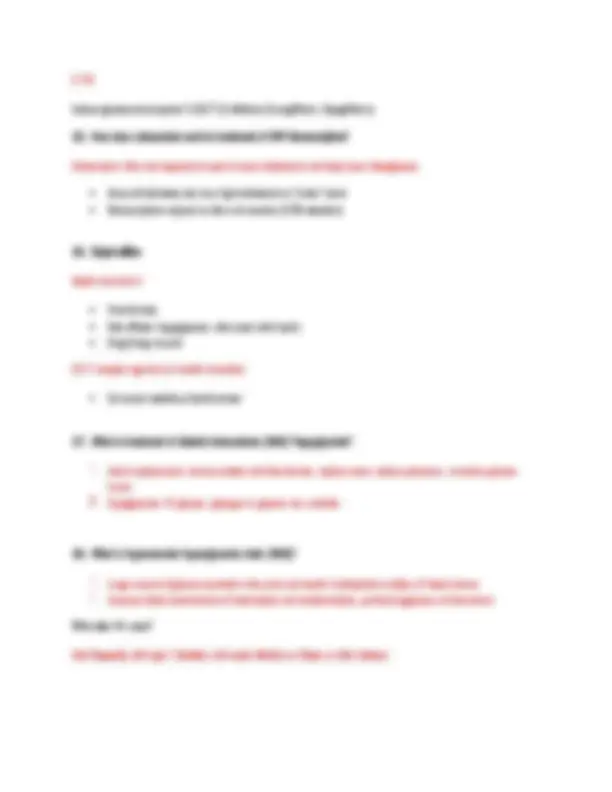

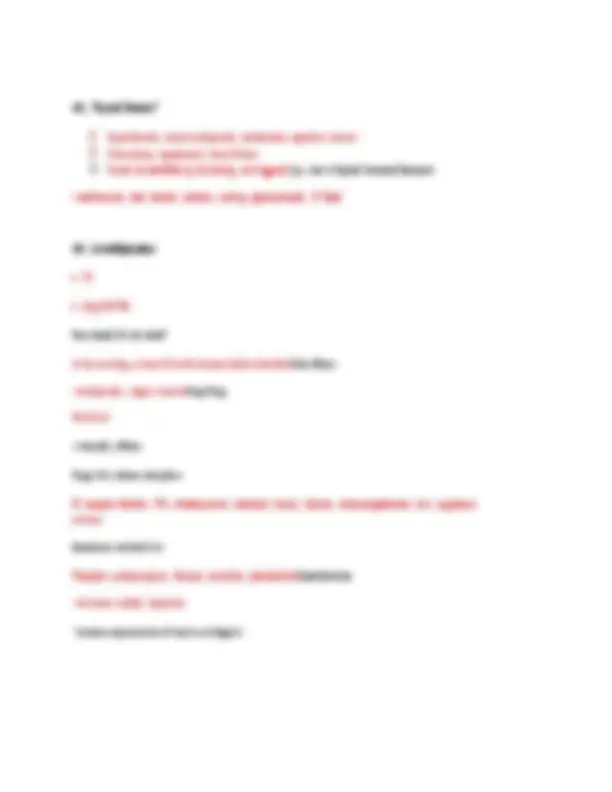
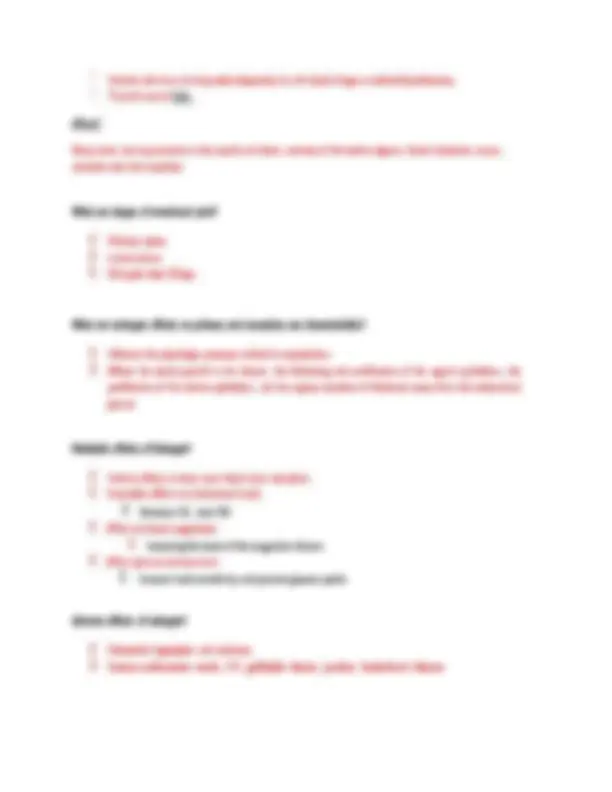
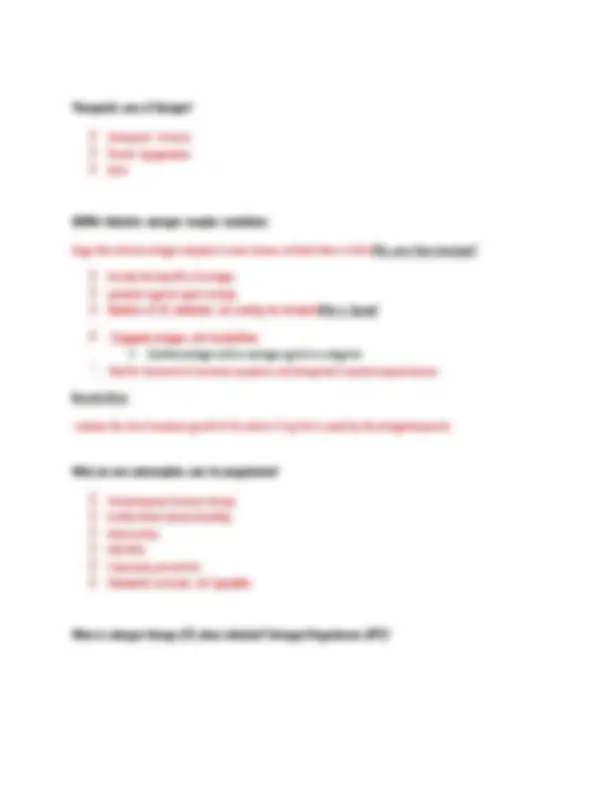
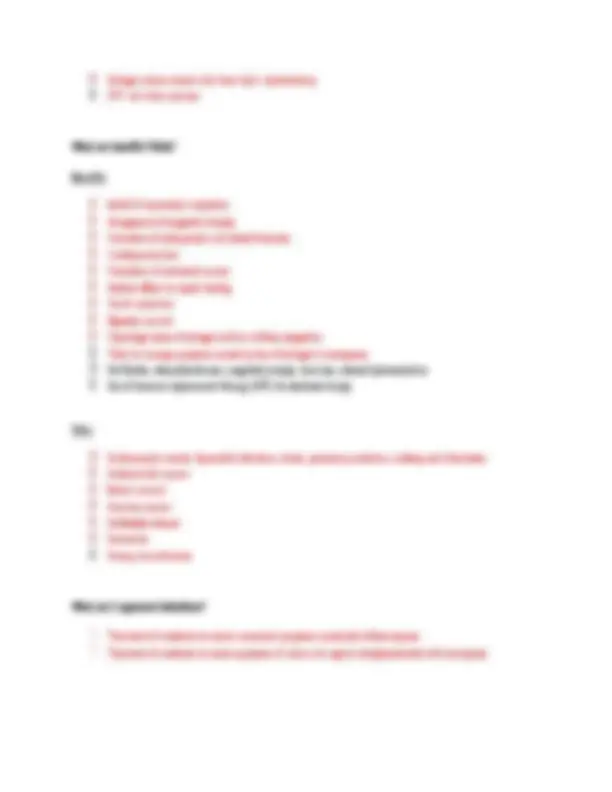
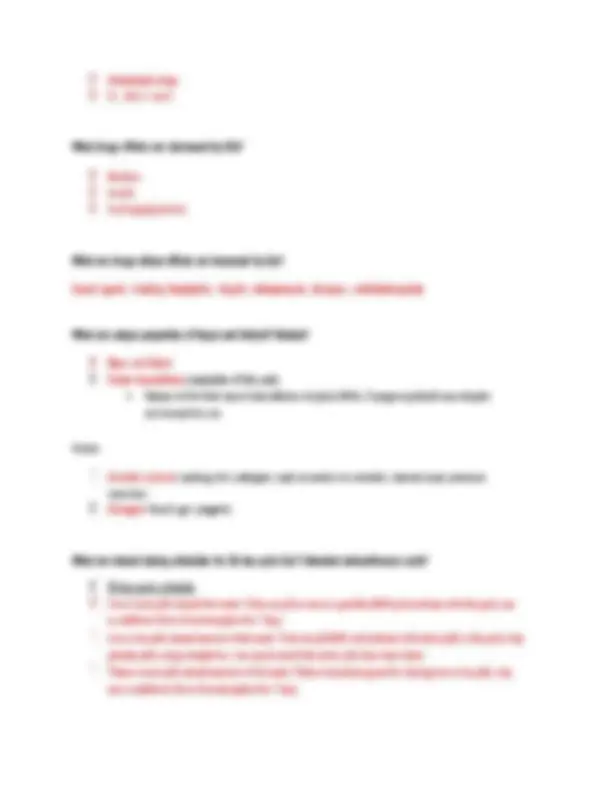
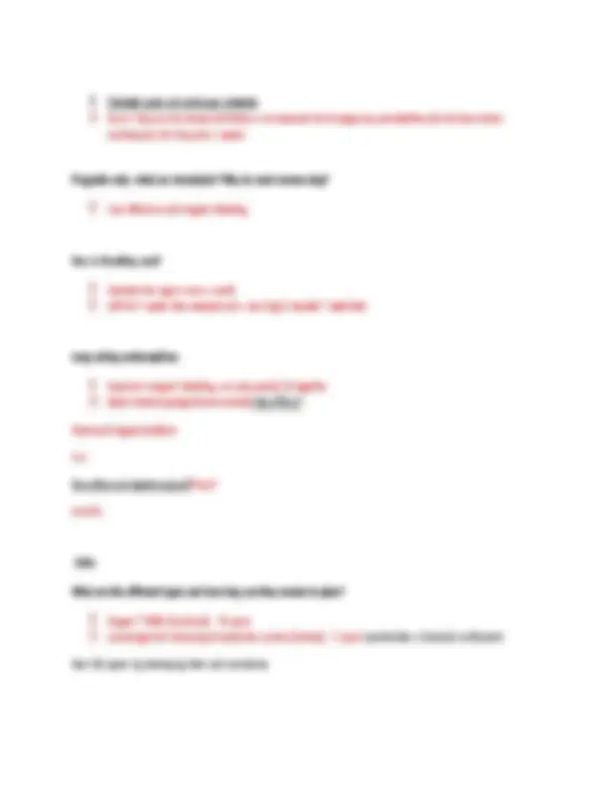
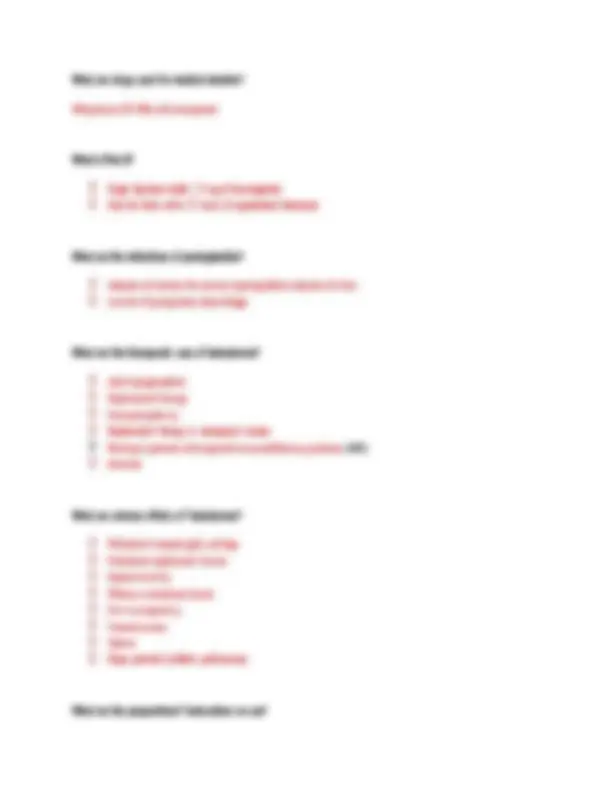
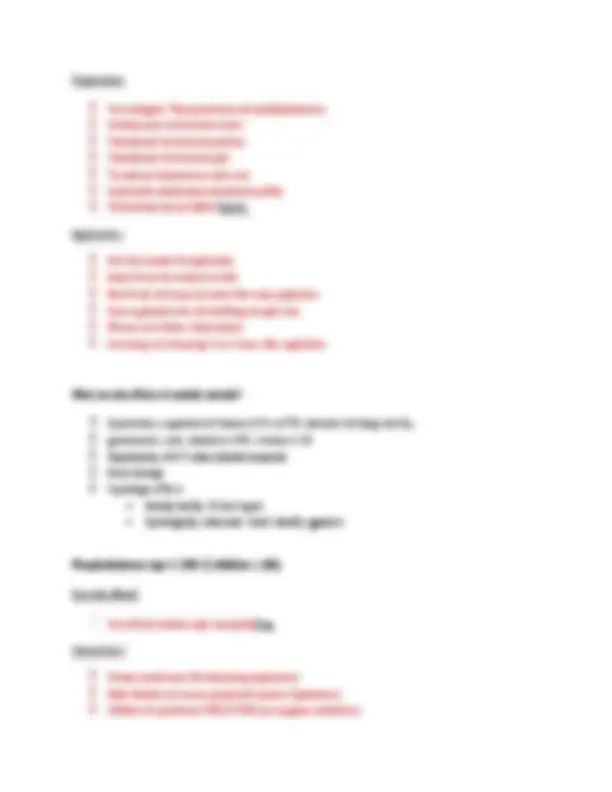
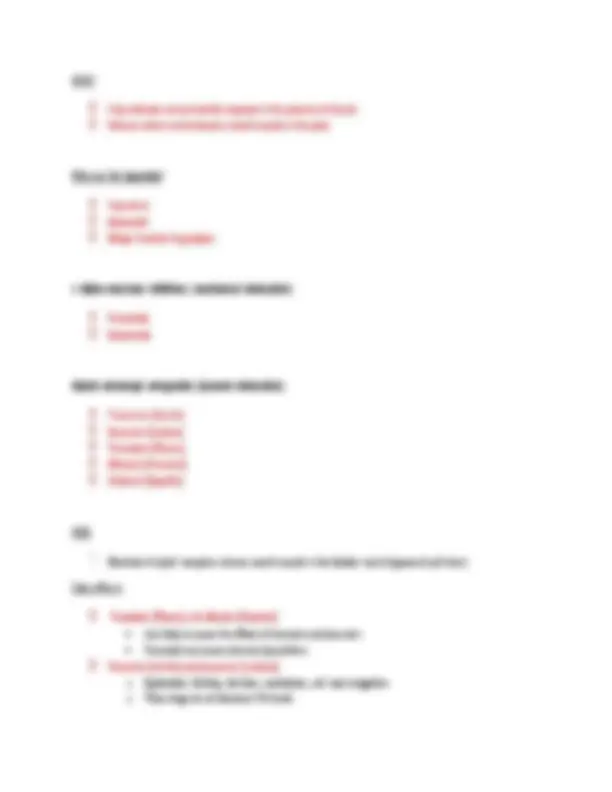
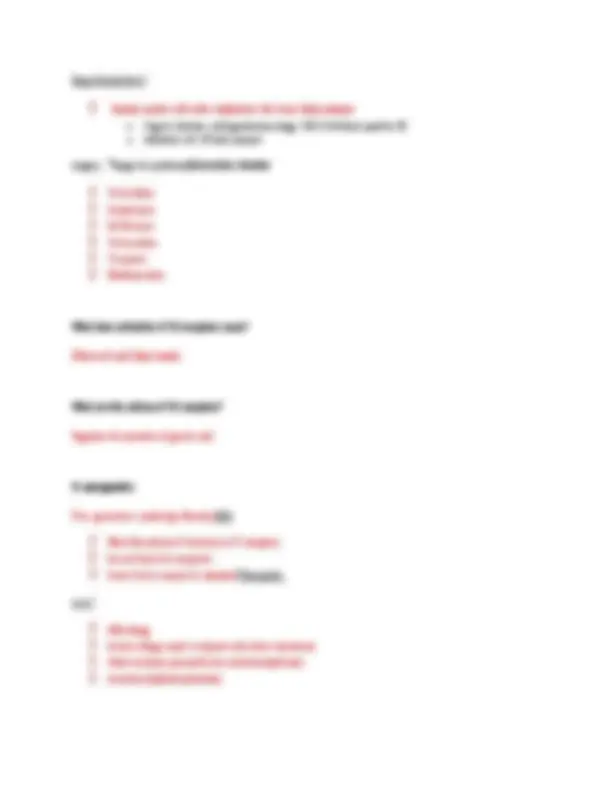
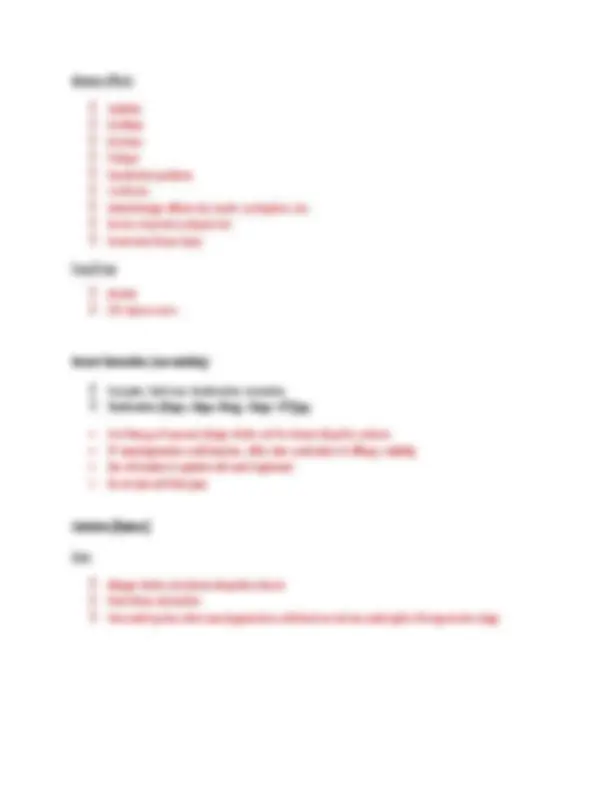
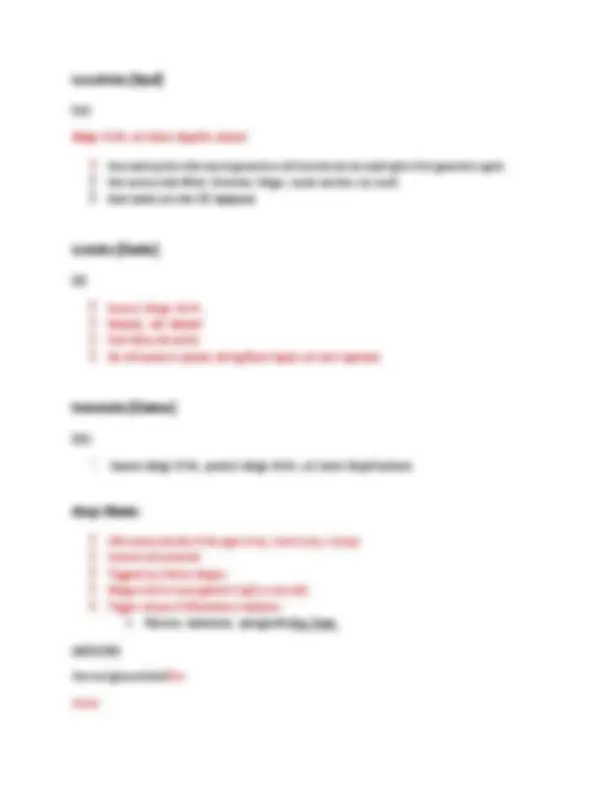
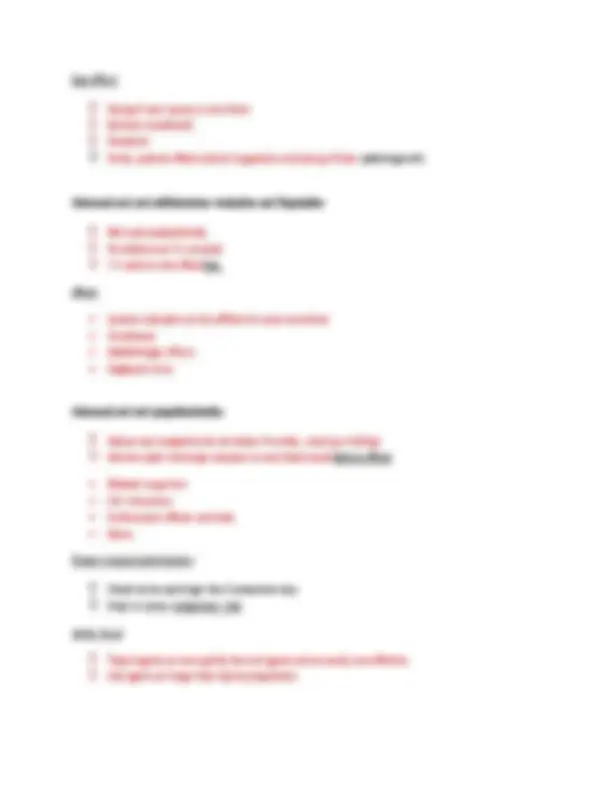
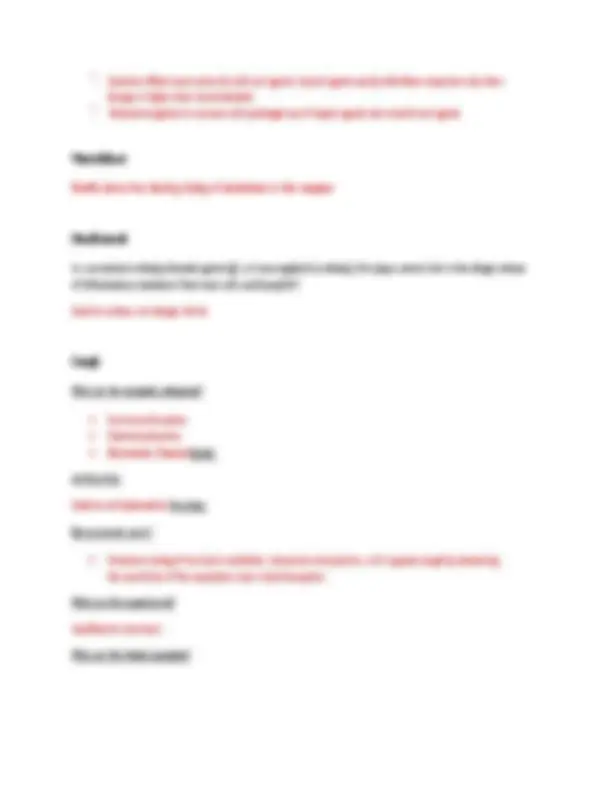
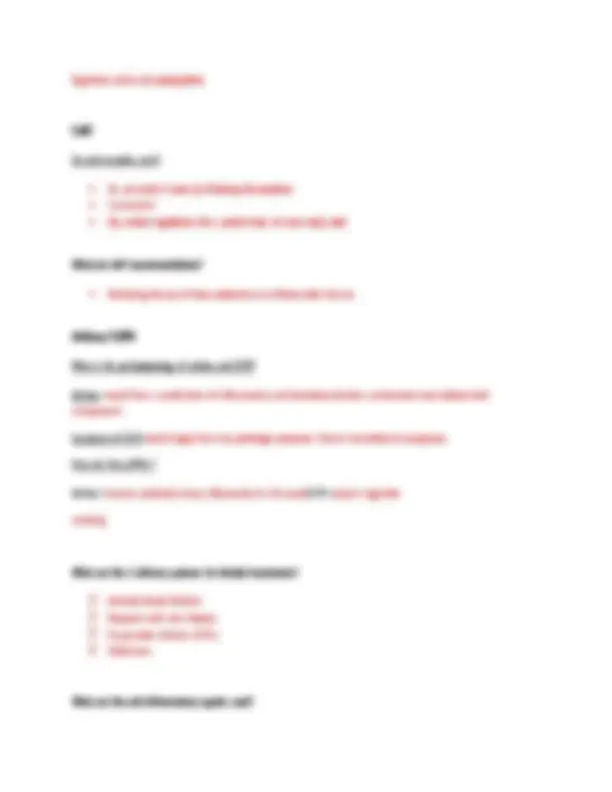
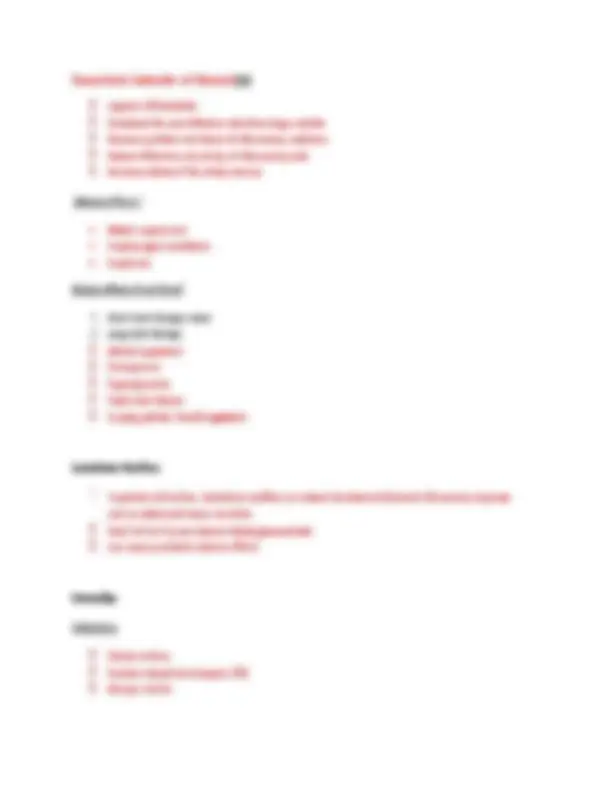
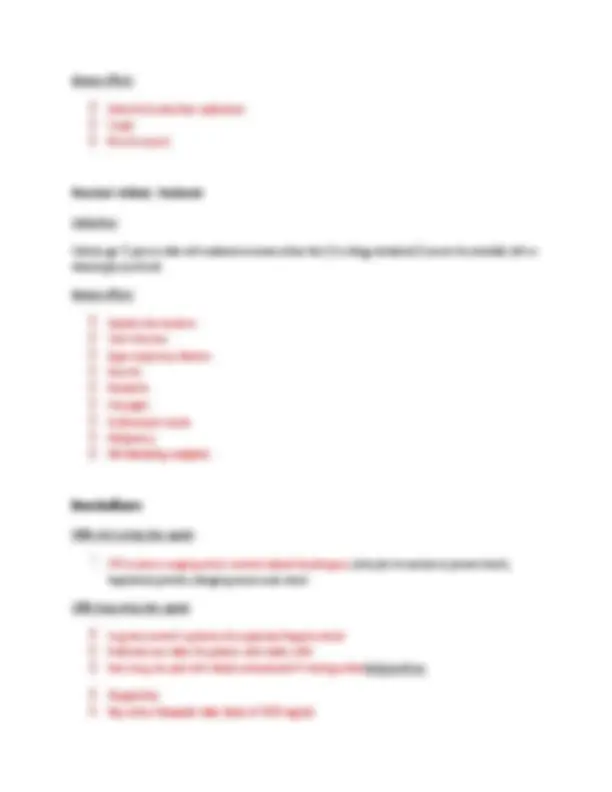

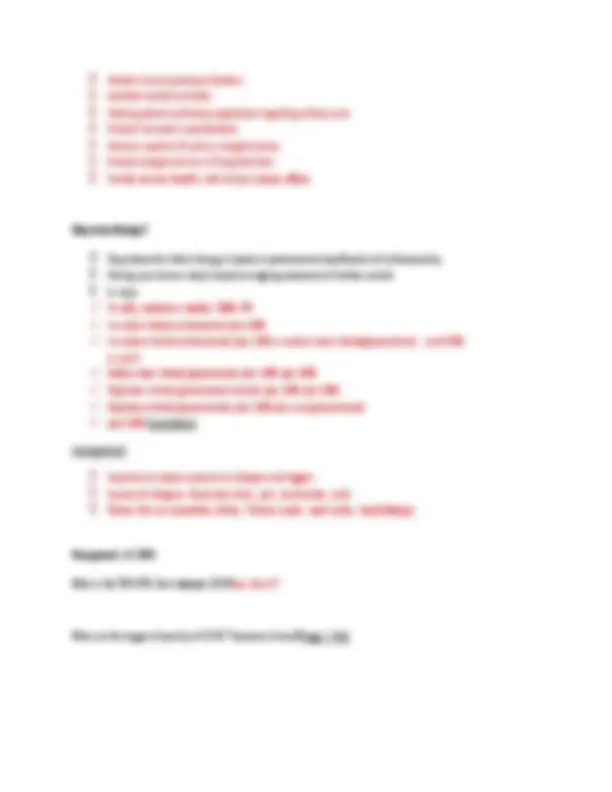

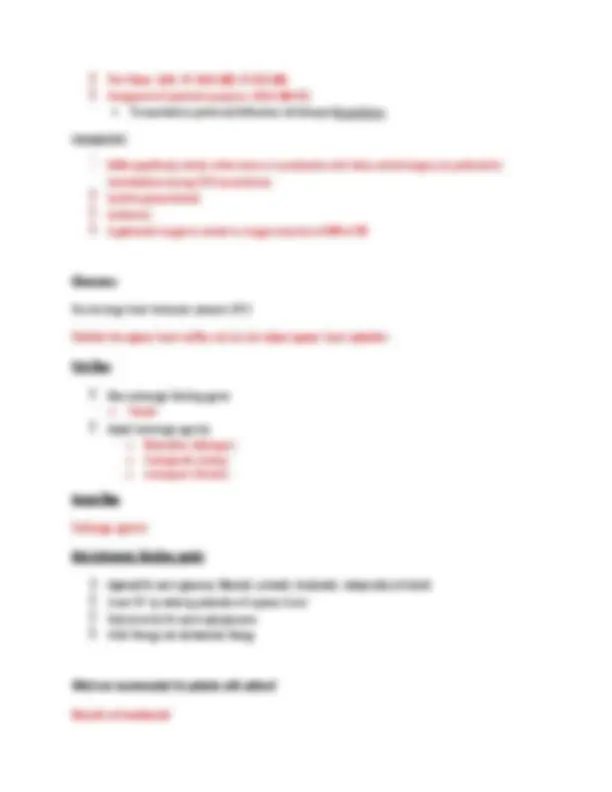
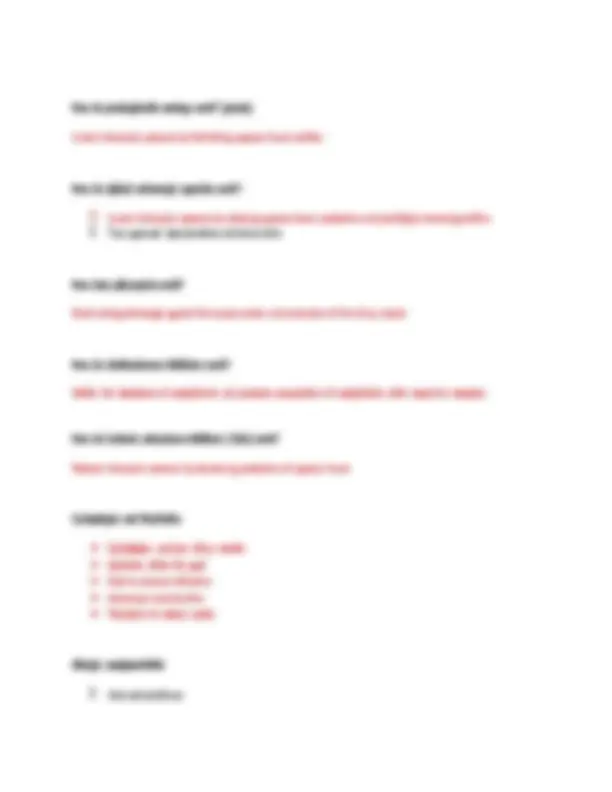
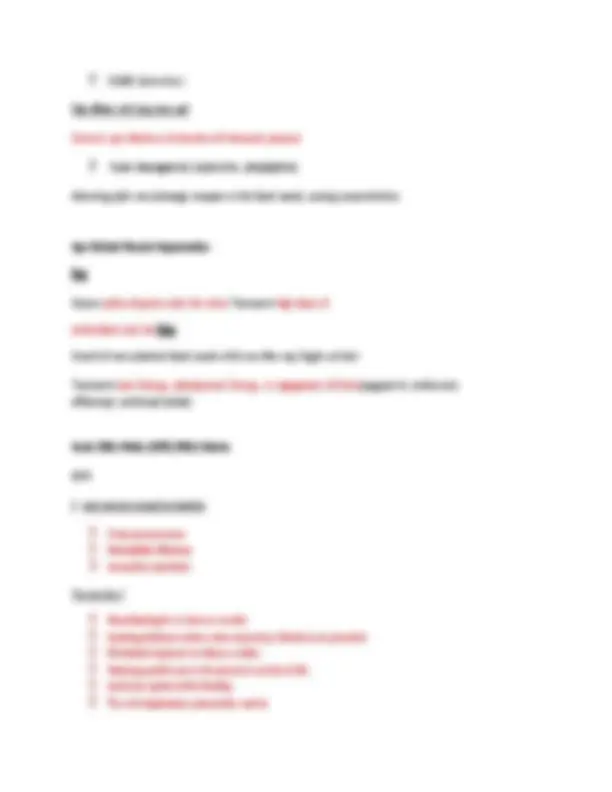
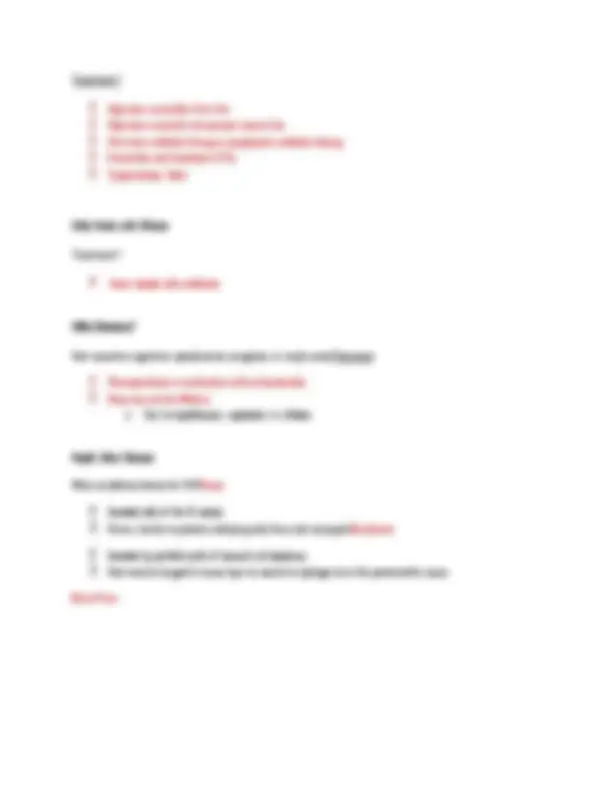
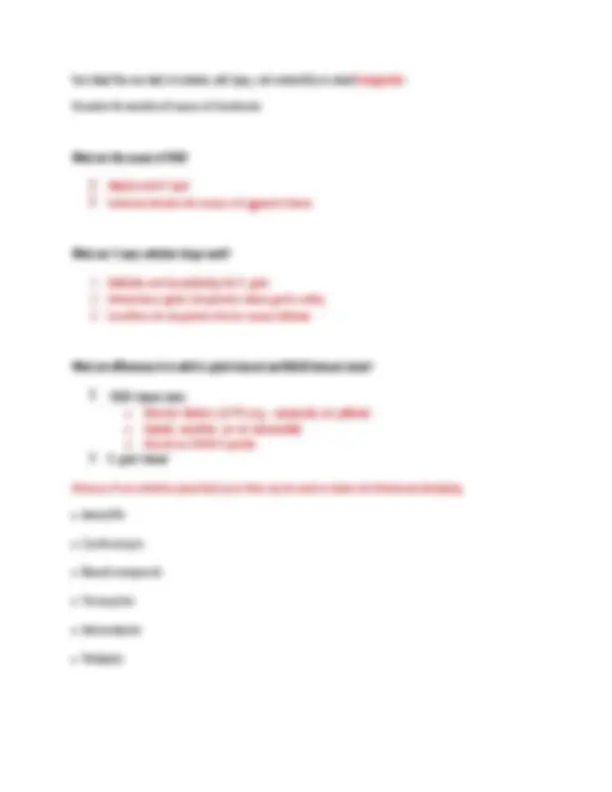
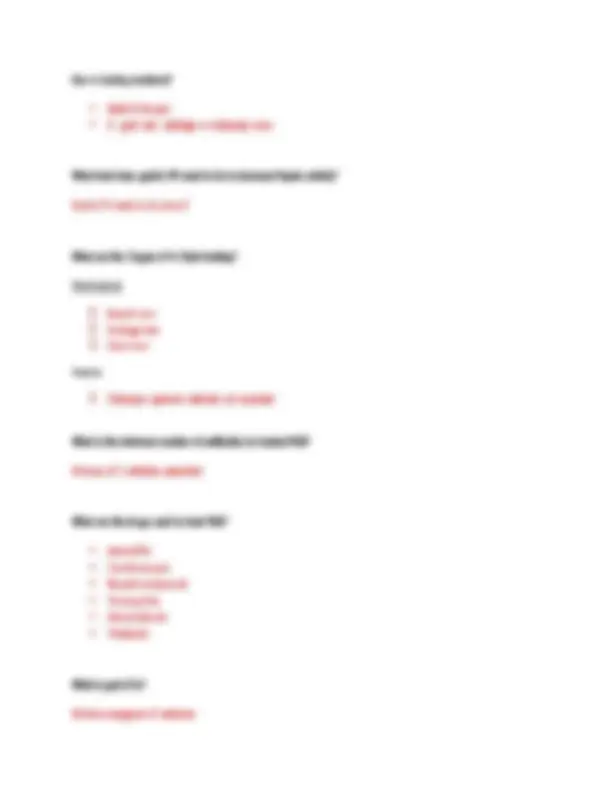
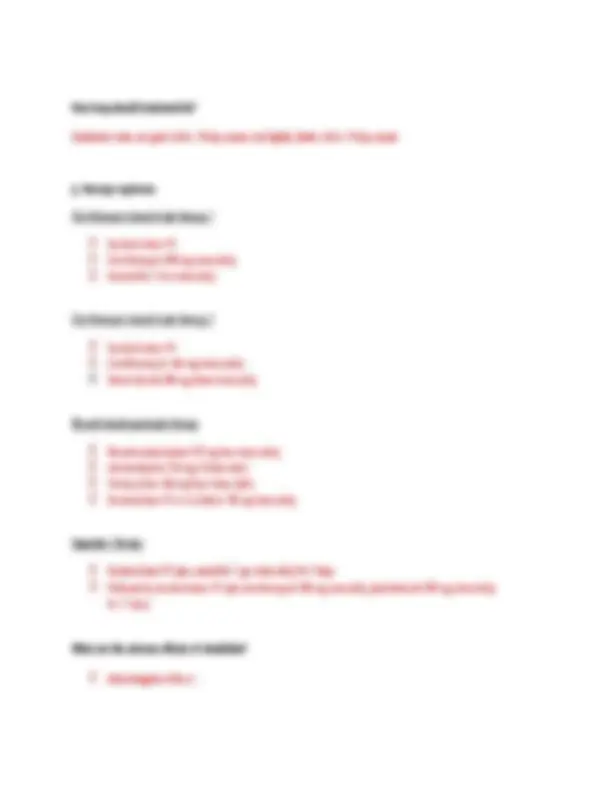
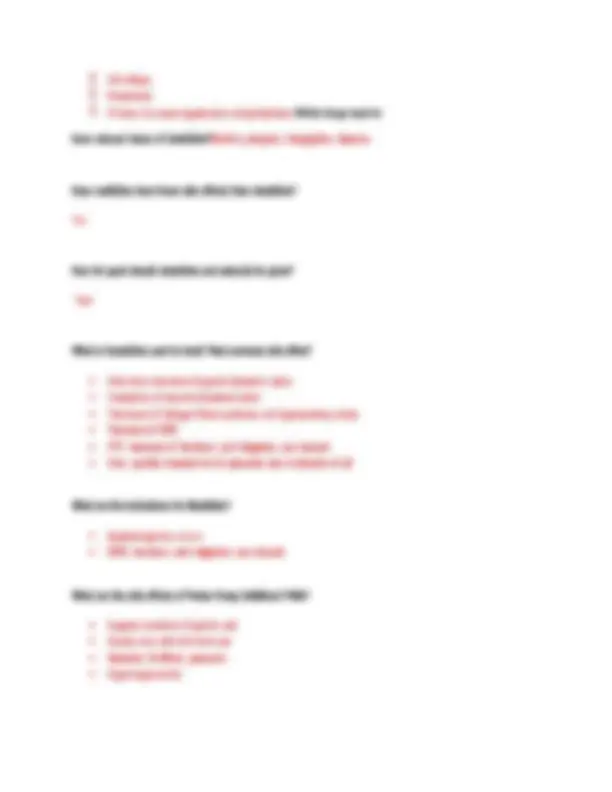

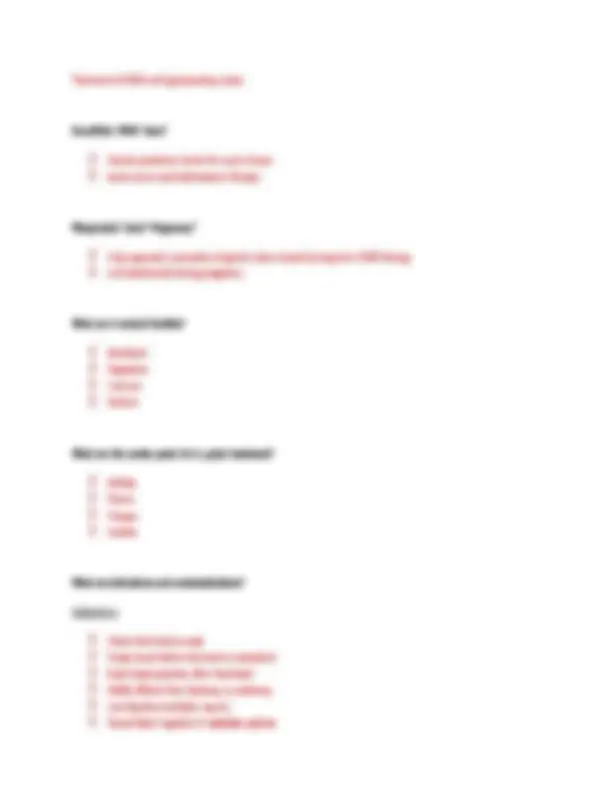
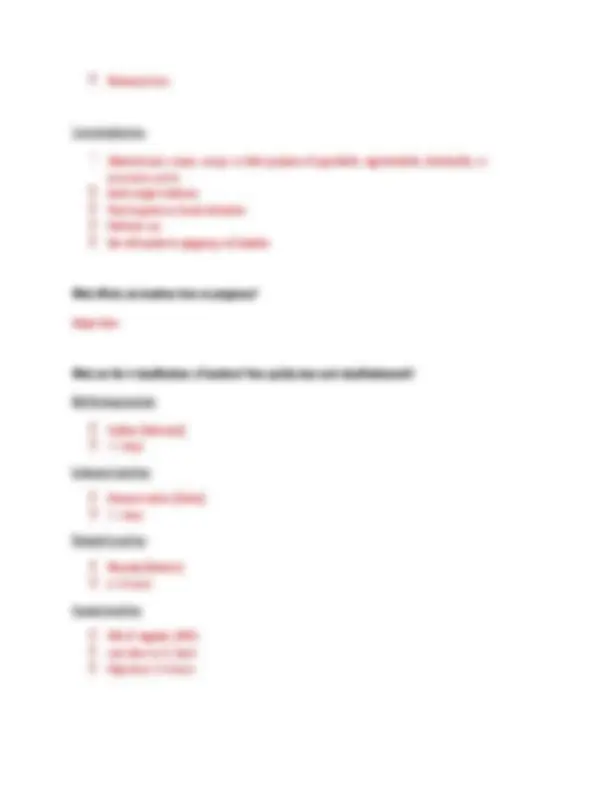
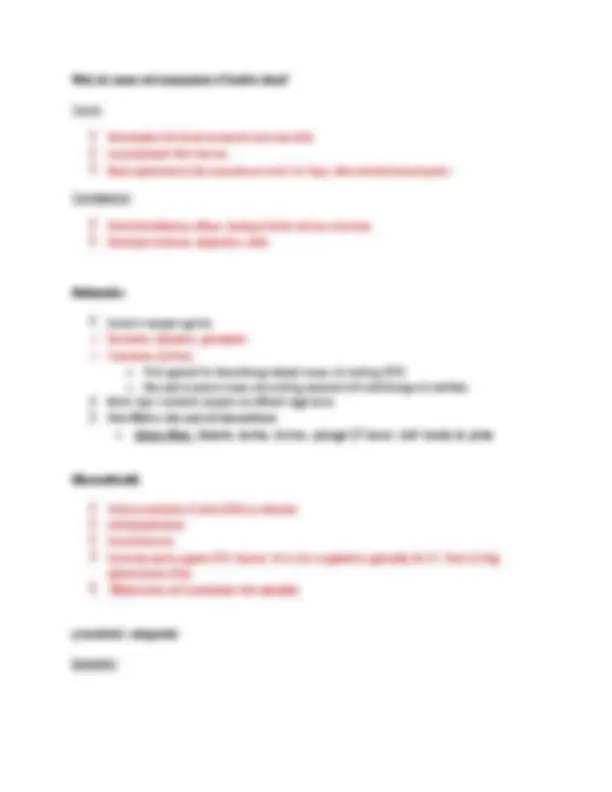
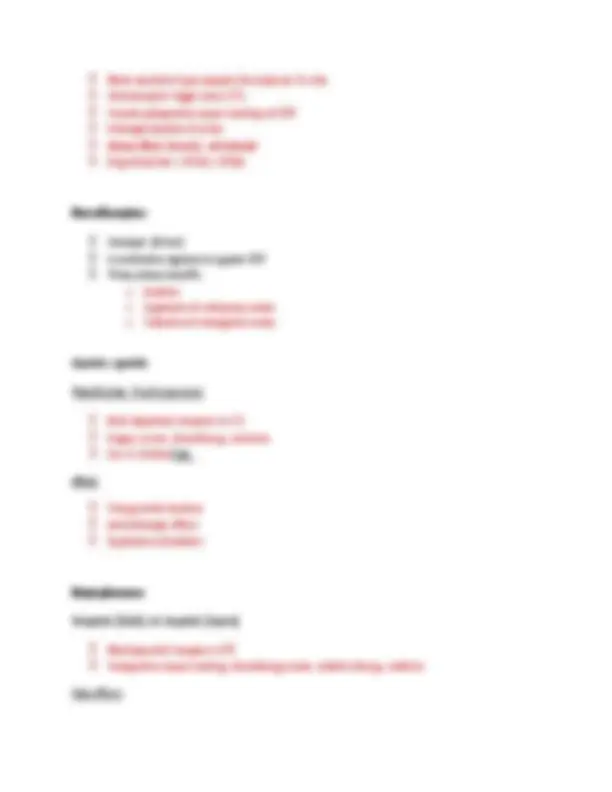
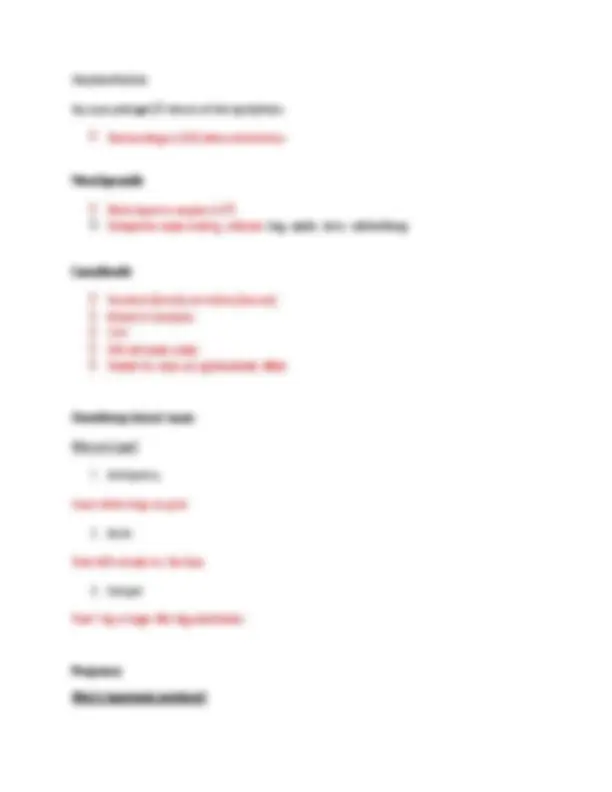
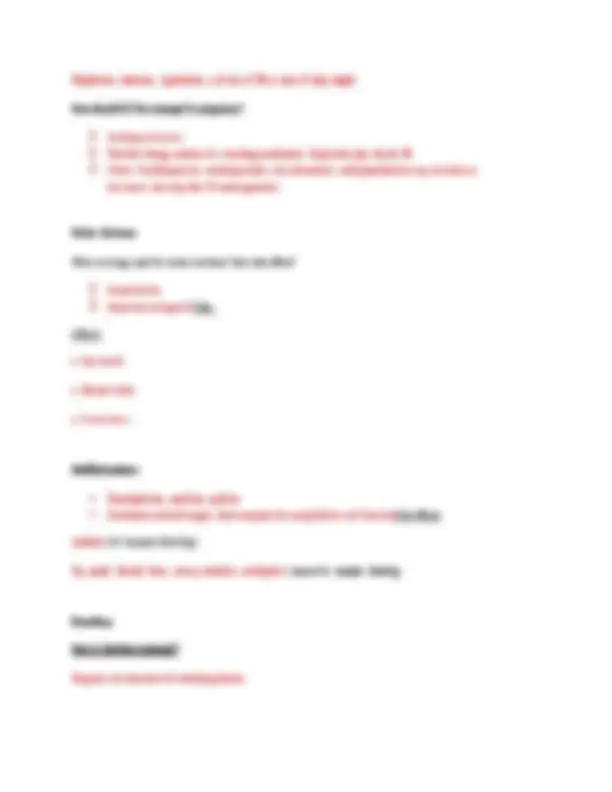
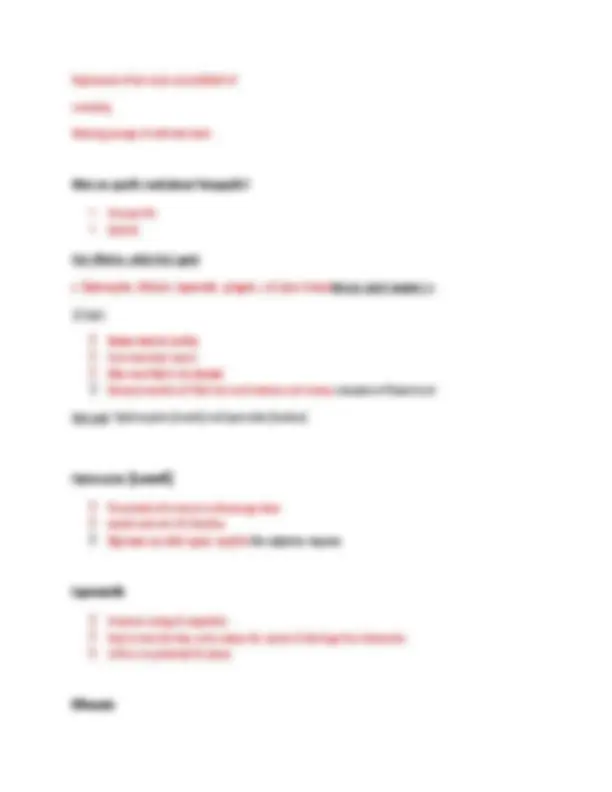
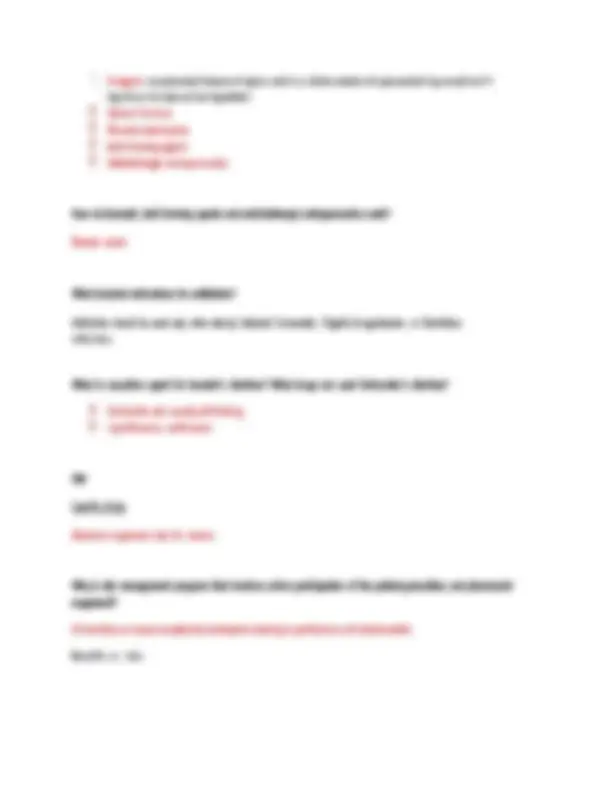
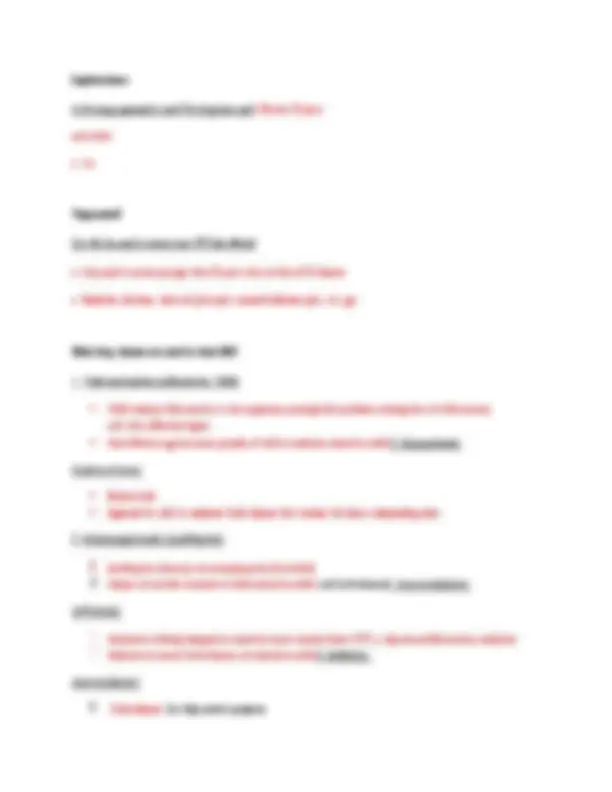
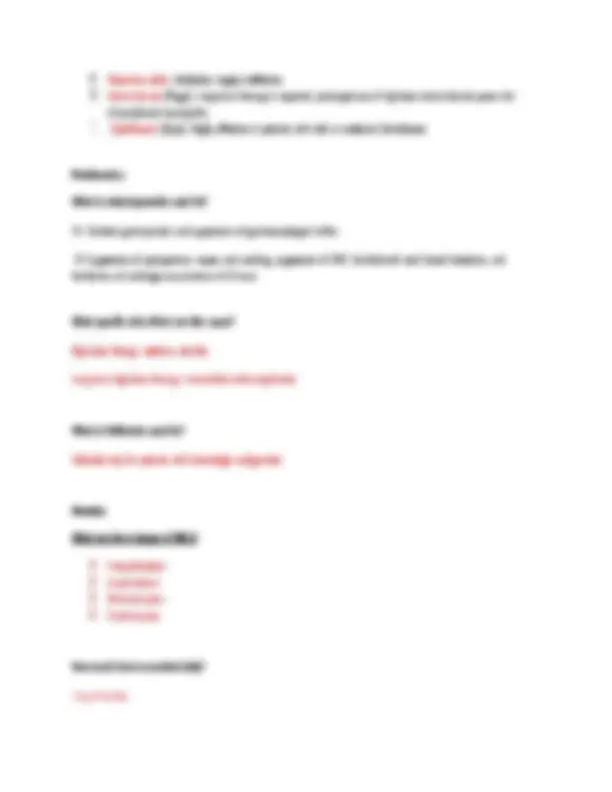
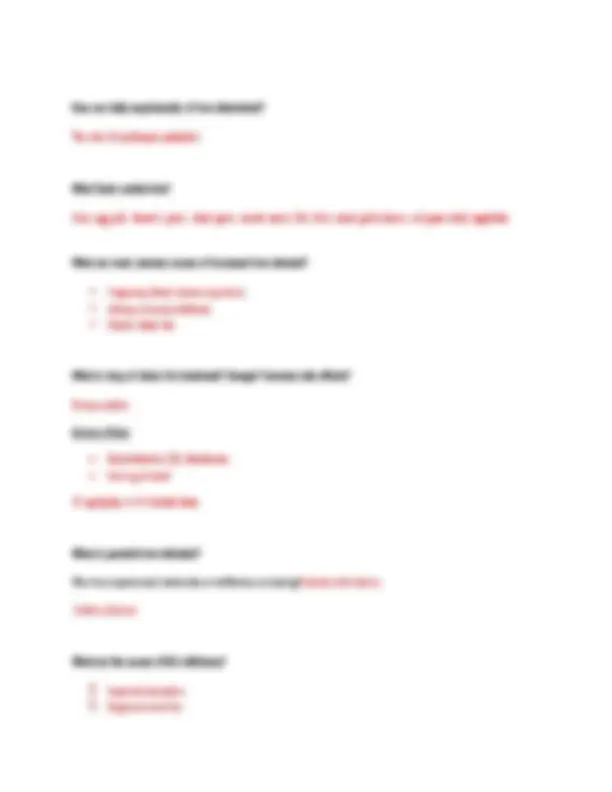
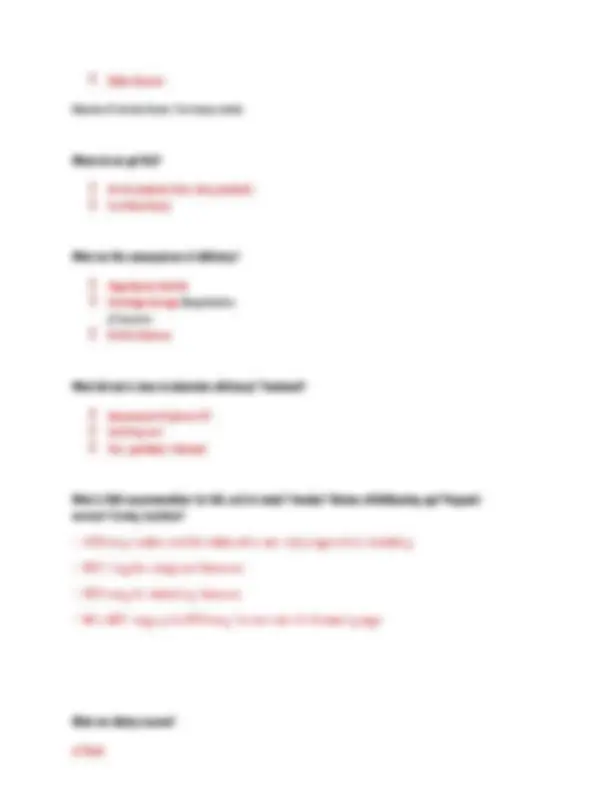
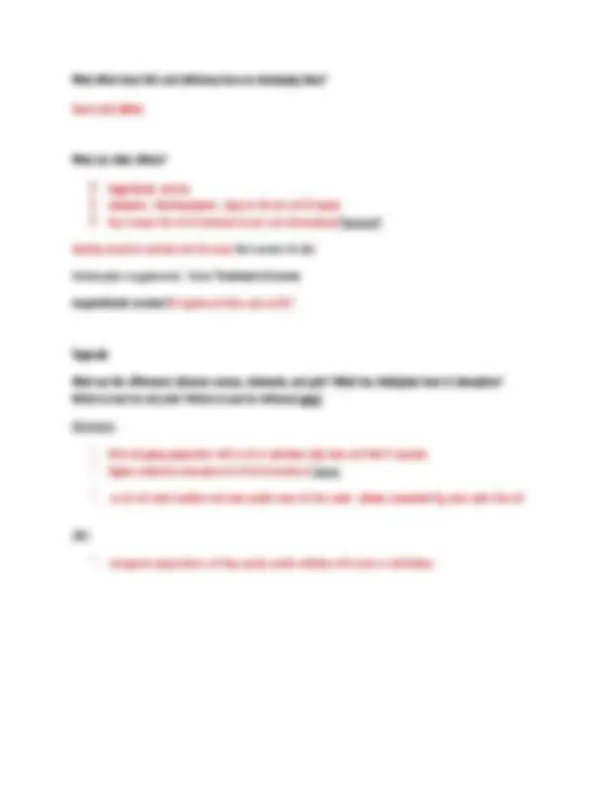
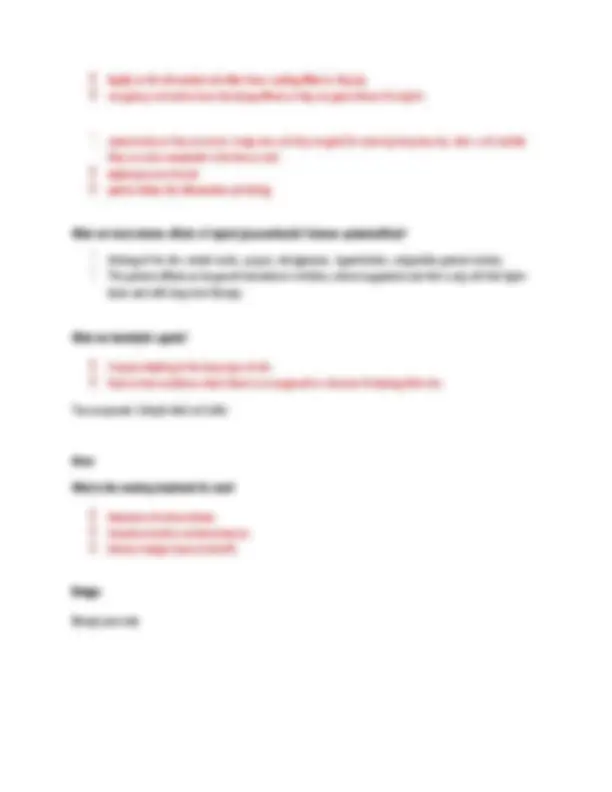
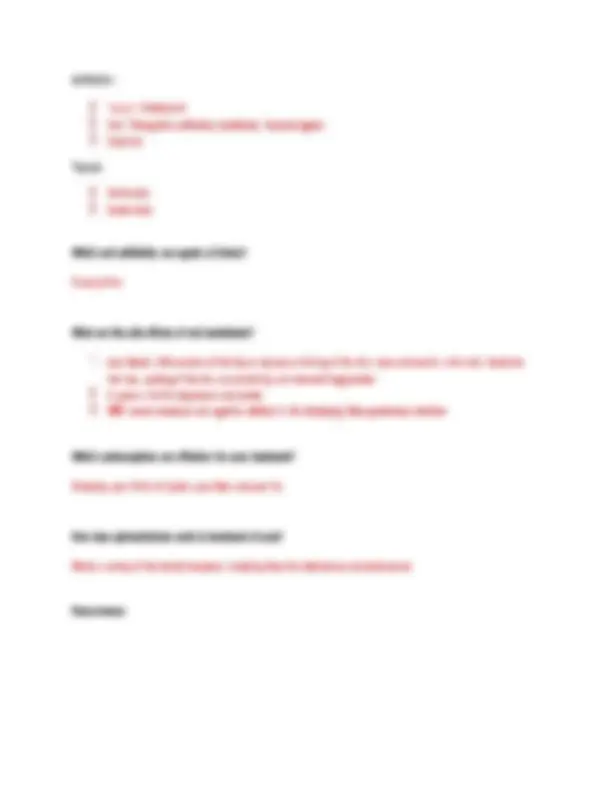
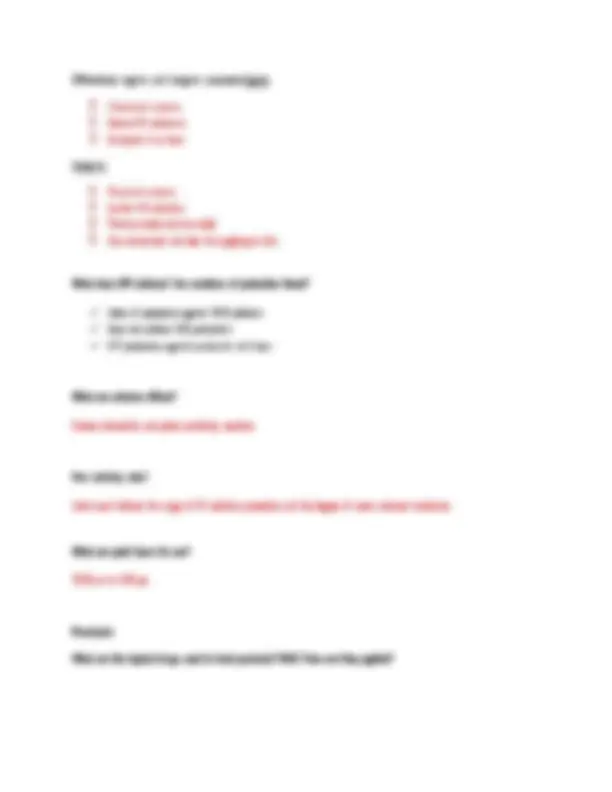
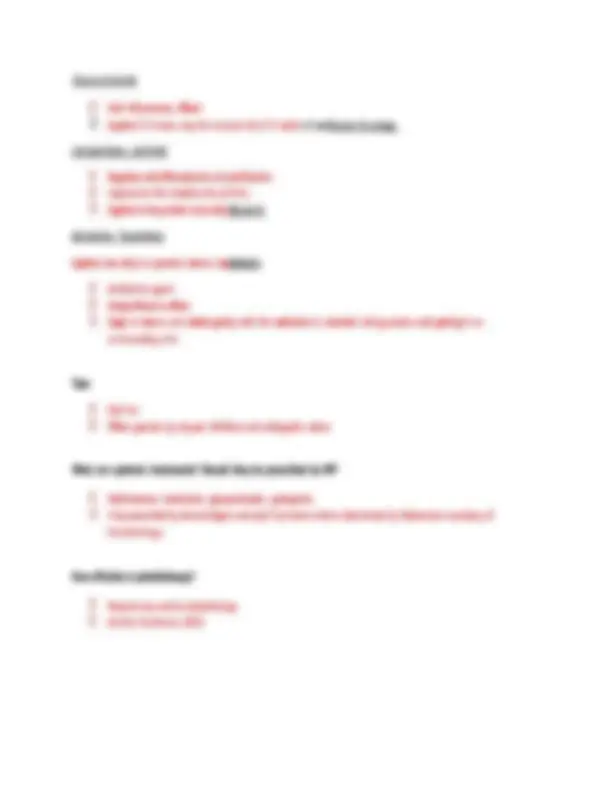
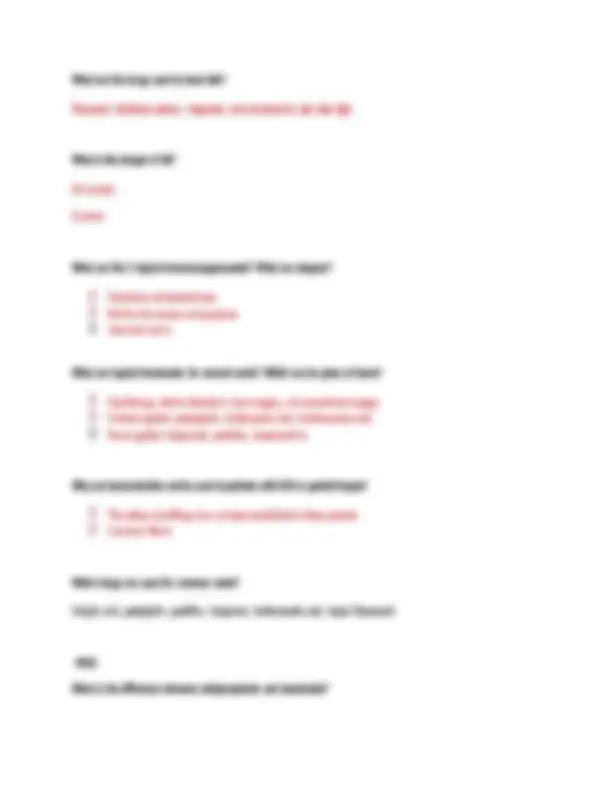
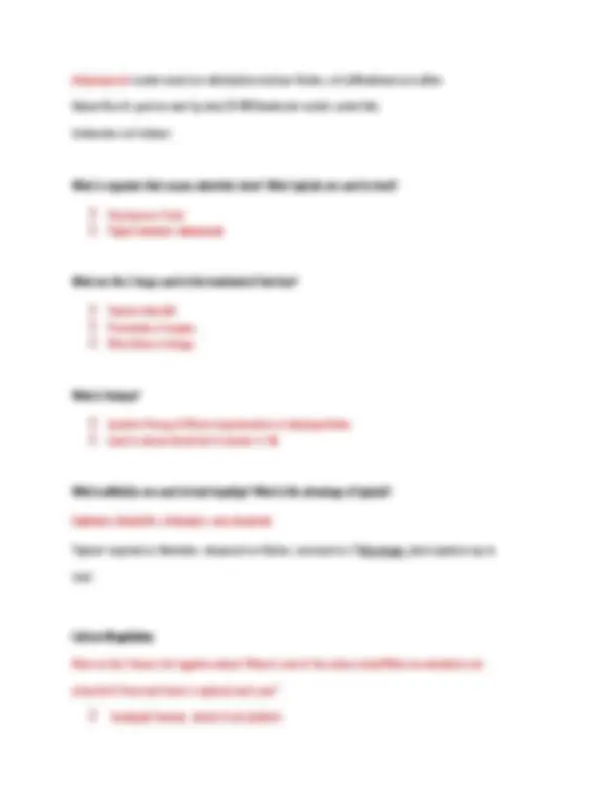
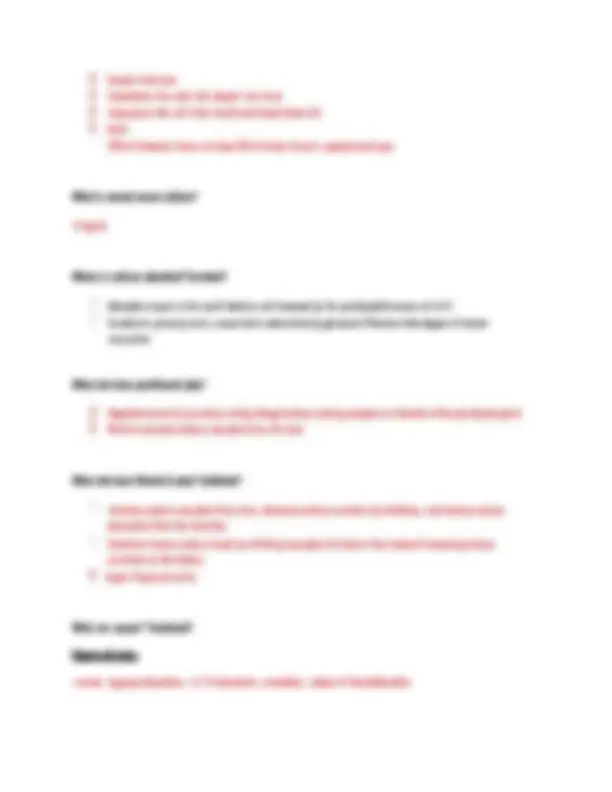
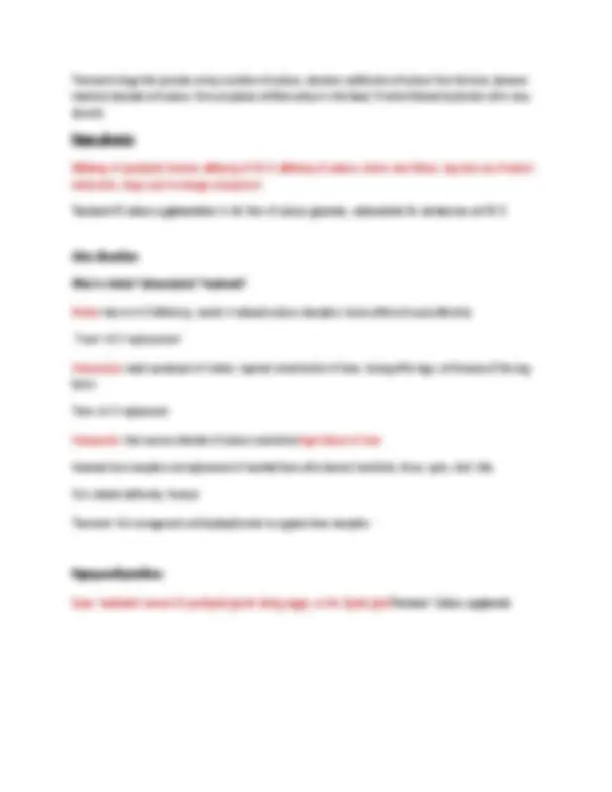
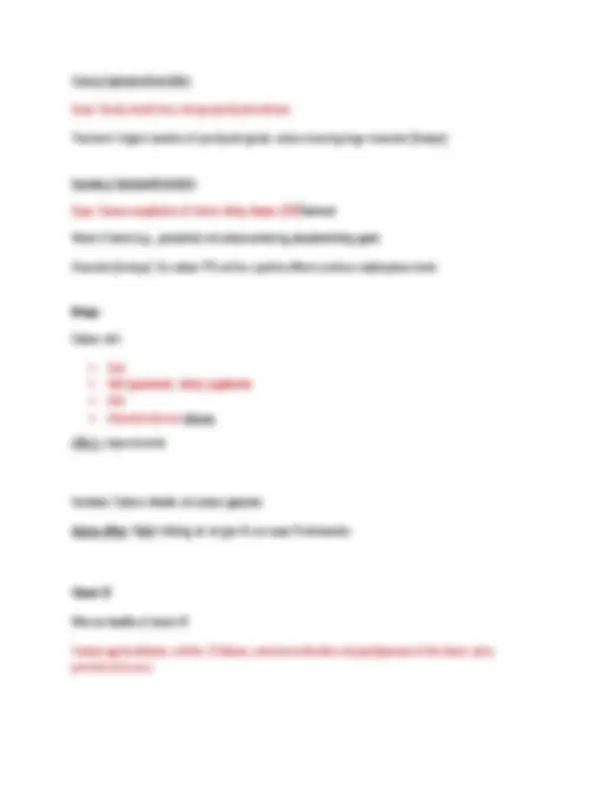
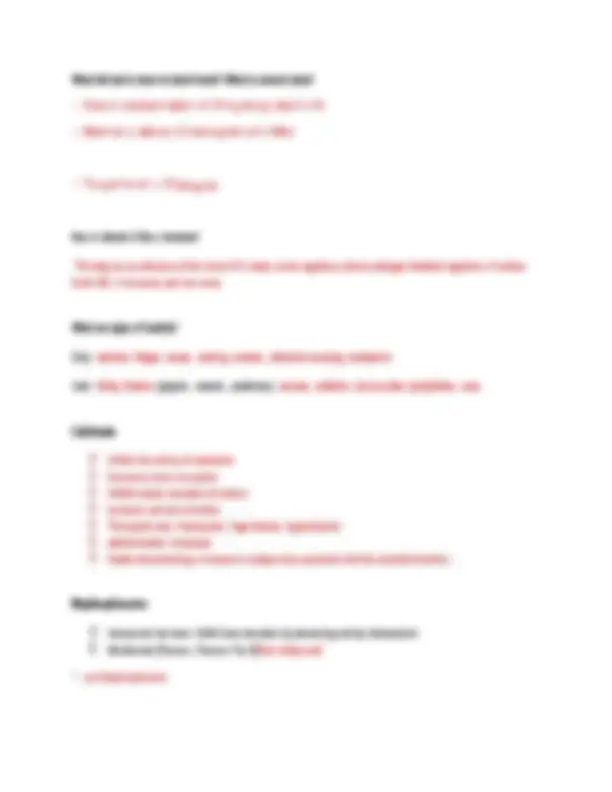

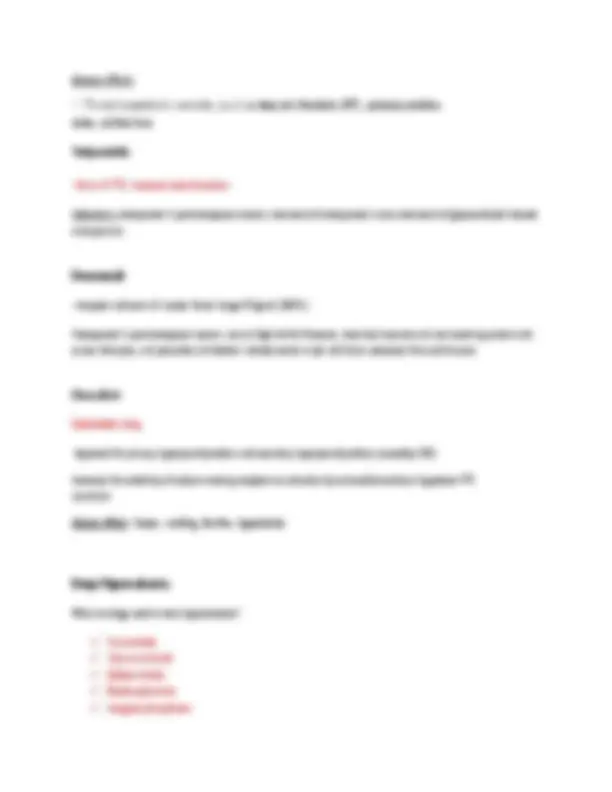
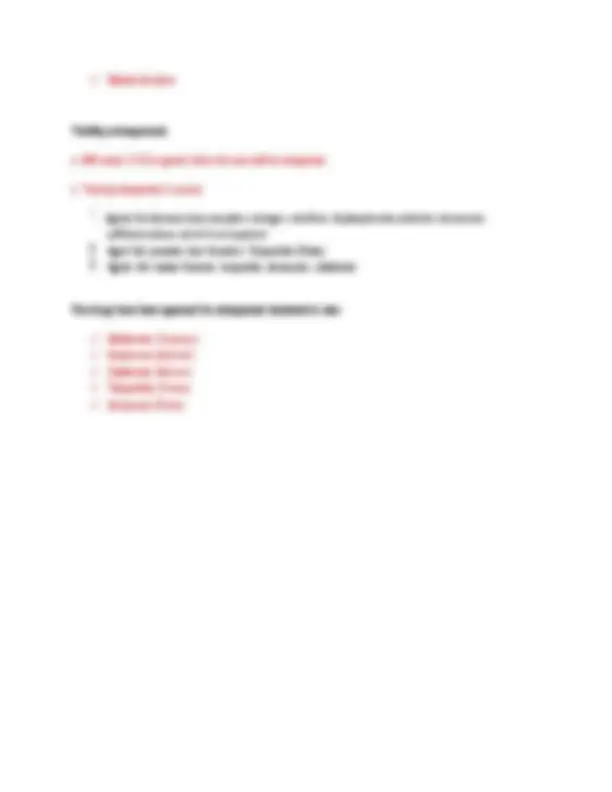


Study with the several resources on Docsity

Earn points by helping other students or get them with a premium plan


Prepare for your exams
Study with the several resources on Docsity

Earn points to download
Earn points by helping other students or get them with a premium plan
Community
Ask the community for help and clear up your study doubts
Discover the best universities in your country according to Docsity users
Free resources
Download our free guides on studying techniques, anxiety management strategies, and thesis advice from Docsity tutors
An overview of various drugs, their mechanisms of action, indications, adverse effects, and interactions. Topics covered include antihistamines, leukotrienes modifiers, monoclonal antibodies, bronchodilators, methylxanthines, anticholinergic drugs, and glucocorticoids. The document also discusses the management of asthma and copd exacerbations, and the use of drugs in specific conditions such as pregnancy, glaucoma, and pneumonia.
Typology: Exams
1 / 68

This page cannot be seen from the preview
Don't miss anything!





























































1. What drugs are used to treat gestational diabetes? Metformin and Insulin 2. What A1C value indicates diabetes mellitus? Pre-DM? 6.5% or greater is considered diabetes5.7-6.4% pre- diabetes 3. What fasting and random values indicate DM? Fasting plasma glucose— 126 or greater is diabetes Random (casual) plasma glucose—anything greater than 200 is diabetes 4. What are complications of insulin therapy? Hypoglycemia Can develop lipohypertrophy Accumulation of subcutaneous fat that occurs when it is injected too frequently atthe same site Allergic reactions Characterized by red and intensely itchy welts, breathing becomes difficult If severe allergy develops: - Desensitization procedure (small doses to larger doses)Hypokalemia Promotes the uptake of potassium cells and insulin activates a membrane-bound enzyme with sodium potassium and ATPase that pumps potassium into the cells and sodium out
5. Drug interactions? Hypoglycemic agents Can intensify the hypoglycemia included by insulin Examples: sulfonylureas, glinides, alcoholUse with caution with hyperglycemic agents Examples: thiazide and glucocorticoids and sympathomimetics 6. What effect do beta blockers have on insulin? ▪ delay awareness of and response to hypoglycemia by masking the signs that areassociated with stimulation of sympathetic nervous system ▪ Impair glycogenolysis ▪ Prevent the bodies counter-regulatory response 7. What are other therapeutic uses besides DM? ▪ Hyperkalemia ▪ Aids in diagnosis of GH deficiency ▪ Diabetic ketoacidosis 8. Insulin dosage must be coordinated with what? Carbohydrate intake 9. What is B/P goal in diabetic? To be controlled, within normal 120/ 10. What medication can be given to decrease risk of diabetic nephropathy? ACE inhibitor or ARB
14. What is the A1C goal? When is goal below 7 not appropriate? ▪ 7% or below ▪ Those with severe hypoglycemia risk, limited life expectancy, advanced microvascular or macro vascular complications—not below 7 15. What are the short acting insulins? Intermediate? Long acting? Short duration: Rapid acting ▪ Insulin lispro [Humalog] ▪ Insulin aspart [NovoLog] ▪ Insulin glulisine [Apidra]Short duration: Slower acting ▪ Regular insulin [Humulin R, Novolin R]Intermediate duration ▪ Neutral protamine Hagedorn (NPH) insulin ▪ Insulin detemir [Levemir]Long duration ▪ Insulin glargine 16. When are short duration insulins used? ▪ Administered in association with meals to control the post-prandial rise in bloodglucose between meals and at night 17. When are intermediate insulins needed? ▪ Administer 2 - 3 times daily to provide glycemic control between meals and duringthe night 18. How long is duration of glargine? Levemir? Degludec? ▪ Glargine—up to 24 hours
▪ Levemir Low dose (0.2 units/kg)— 12 hours High doses (0. units/kg)— 20 - 24 hours ▪ Degludec—up to 42 hours
19. What are routes of administration? Which can be inhaled? SQ injection IV infusion Inhalation—Afrezza, mealtime insulin 20. What is typical dosing for type 1? Type 2? Total doses may range from 0.1 unit/kg body weight to more than 2.5 units/kgType 1 ▪ Initial doses typically range from 0.5-0.6 units/kg per dayType 2 ▪ Initial doses range from 0.2-0.6 units/kg per day ▪ Dosage increased or decreased according to carb intake, activity 21. What are the 3 dosing schedules? Twice daily dosing Intensive basal/bolus strategy Continued subcutaneous insulin 22. How does metformin work? Inhibits glucose production in the liver Reduces glucose absorption in the gut Sensitizes insulin receptors in target tissues (fat and skeletal muscle) thusincrease glucose uptake and response to whatever insulin is available
Hypoglycemia Weight gain
29. How does cimetidine effect? Beta blocker? Cimetidine—intensifies the response Beta blockers—diminish the benefits by suppressing the insulin release 30. Meglitinides (Repaglinide and Nateglinide) MOA—stimulate pancreatic insulin release Drug/Drug interaction—gemfibrozil 31. Thiazolidinediones (glitazones) Reduce glucose levels primarily by decreasing insulin resistance Only indication is type 2 diabetes, mainly as an add-on to metformin Rosiglitazone [Avandia]: Restricted use Pioglitazone [Actos] ▪ Can they be used in patient with CHFNo 32. Alpha-glucosidase inhibitors (Acarbose or Precose; Miglitol (glyset)) What races are these more effective in?Latinos and African Americans 33. DPP- 4 inhibitors (gliptins) ▪ MOA—promote glycemic control by enhancing the actions of the incretinhormones and they stimulate glucose dependent release of insulin ▪ Suppress your post-prandial release of glucagon 34. What is the % of A1C reduction?
Sodium-glucose cotransporter 2 (SGLT-2) inhibitors (Canagliflozin, Dapagliflozin)
35. How does colesevelam work in treatment of DM? Bromocriptine? Colesevelam—bile acid sequestrant used to lower cholesterol and helps lower bloodglucose - Many with diabetes also have high cholesterol so 2 birds- 1 stone - Bromocriptine—adjunct to diet and exercise (0.5% reduction) 36. Injectables Amylin memetics? - Pramlintide - Side effects—hypoglycemia when used with insulin - Drug/Drug—insulin GLP- 1 receptor agonists (or incretin mimetics) - Can cause medullary thyroid cancer 37. What is treatment of diabetic ketoacidosis (DKA)? Hypoglycemia? Insulin replacement, reverse acidosis with bicarbonate, replace water, sodium,potassium, normalize glucose levels Hypoglycemia—IV glucose, glucagon is glucose not available 38. What is hyperosmolar hyperglycemia state (HHS)? Large amount of glucose excreted in the urine and results in dehydration andloss of blood volume Increases blood concentration of electrolytes and nonelectrolytes, particularlyglucose and hematocrit When does this occur? Most frequently with type 2 diabetics with acute infection or illness or other stressors
45. Thyroid Storm? Hyperthermia, severe tachycardia, restlessness, agitation, tremor Unconscious, hypotensive, heart failure Cannot be identified by lab testing, not triggered by a rise in thyroid hormonesTreatment —methimazole, beta blocker, sedation, cooling, glucocorticoids, IV fluids 46. Levothyroxine o T o Long half life How should this be taken? In the morning, at least 30 to 60 minutes before breakfastSide effects —tachycardia, angina tremorsDrug/Drug Warfarin —intensify effects Drugs that reduce absorption H2 receptor blockers, PPIs, cholestyramine, colestipol, Maalox, Mylanta, calciumsupplements, iron, magnesium, orlistat Accelerate metabolism Phenytoin, carbamazepine, rifampin, sertraline, phenobarbitalCatecholamines —increase cardiac responses Increase requirements of insulin and digoxin
How is this dosed? How does dosage differ for someone over 50? 65 and older?Someone with heart disease? Overweight? Underweight? 1.6-1.8 mcg/kg/day Obese—go by ideal body weight Underweight—actual weight Older patients with CAD—start with 12.5- 25 mcg Elderly—start low and go slow Younger than 3 months— 10 to 15 mcg/kg/day Children (3- 5 months)—8 to 10 mcg/kg/day Children (6- 11 months)— 6 to 8 mcg/kg/day Children 1 - 5 years— 5 to 6 mcg/kg/day Children 6 - 12 — 4 to 5 mcg/kg/day Liotrix—a mixture of synthetic T4 plus synthetic T3 in a 4:1 fixed ratio Because levothyroxine alone produces the same ratio of T4 to T3, Liotrix offers noadvantage over levothyroxine for most indications Armour—consists of desiccated animal thyroid glands. Standardization is based on content of iodine, levothyroxine, and liothyronine. The ratio of levothyroxine to lipthyronine is not less than 5: Thyroid is available in tablets (15- 300 mg) Methimazole—used in hyperthyroidism Cell form of therapy for Graves’ disease Adjunct to radiation therapy until the effects of radiation become manifested Suppresses the thyroid hormone synthesis in preparation for thyroid glandsurgery Thyrotoxic crisis Propylthiouracil
effects? Patients who have not responded adequately to anti-thyroid drugs or subtotalthyroidectomy Thyroid cancerSide Brassy taste, burning sensation in the mouth and throat, soreness of the teeth andgums, frontal headache, coryza, salvation and skin eruptions What are stages of menstrual cycle? Follicular phase Luteal phase Full cycle about 28 days What are estrogen effects on primary and secondary sex characteristics? Influence the physiologic processes related to reproduction Affects the ductal growth in the breasts, the thickening and cornification of the vaginal epithelium, the proliferation of the uterine epithelium, and the copious secretion of thickened mucus form the endocervical glands Metabolic effects of Estrogen? Positive effect on bone mass—block bone resorption Favorable effects on cholesterol levels Decrease LDL, raise HDL Effect on blood coagulation Increasing the levels of the coagulation factors Affect glucose homeostasis Increase insulin sensitivity and promote glucose uptake Adverse effects of estrogen? Endometrial hyperplasia and carcinoma Increase cardiovascular events, N/V, gallbladder disease, jaundice, headacheand chloasma
Therapeutic uses of Estrogen? Menopausal hormone Female hypogonadism Acne SERMS—Selective estrogen receptor modulators drugs that activate estrogen receptors in some tissues and block them in othersWhy were these developed? Provide the benefits of estrogen protection against vaginal atrophy Reduction of LDL cholesterol, but avoiding the drawbacksWhat is Duavee? Conjugated estrogens with bazedoxifene
Prevention of postmenopausal osteoporosis Birth Control What are pharmacologic and nonpharmacologic methods of birth control? Pharmacologic methods of contraception Oral contraceptives Etonogestrel implants Injectable medroxyprogesterone acetate Intrauterine devices Vaginal rings Transdermal patches Nonpharmacologic methods of contraception Surgical sterilization (tubal ligation, vasectomy) Mechanical devices (condom, diaphragm, cervical cap) Avoiding intercourse during periods of fertility (calendar method, temperaturemethod, cervical mucus method) How should you select a method? Consider effectiveness, safety, personal preference Oral contraceptives MOA—inhibit ovulation What are categories? Subgroups? Classification (two main categories) Combination oral contraceptives (OCs) Estrogen and progestin Progestin-only OCs (―mini-pills‖) Three major subgroups of combination OCs
Monophasic Biphasic Triphasic What are 3 estrogens in OCPs? Progesterone? 1st gen? 2nd gen? 3rd gen? 4thgen? Estrogens—ethinyl, estradiol, estriol and estradiol valerate Progesterone— 4 generations 1st generation—ethynodiol diacetate and norethindrone 2nd gen—levonorgestrel and norgestrel 3rd gen—desogestrel and norgestimate 4th gen—dienogest and drospirenone Combination Ocs Adverse effects? Thyrombolytic disorders Increase risk—heavy smoking, a history of thrombo embolism, thrombophilias Hypertension Cancer Stroke in patients with migraine Teratogenic effects Abnormal uterine bleeding Use in pregnancy and lactation Benign hepatic adenoma Glucose intolerance Noncontraceptive uses? Decrease risks of ovarian cancer, endometrial cancer, ovarian cysts, pelvic inflammatory disease, benign breast disease, iron deficiency anemia, and acne Favorable effect on menstrual cycles
Extended cycle and continuous schedules Up to 7 days can be missed with little or no increased risk of pregnancy providedthe pills had been taken continuously for the prior 3 weeks Progestin only: what are drawbacks? Why do most women stop? Less effective and irregular bleeding How is NuvaRing used? Inserted into vagina once a month Left for 3 weeks then removed and a new ring is inserted 1 week later Long-acting contraceptives Implants—irregular bleeding, can stop period all together Depot medroxyprogesterone acetateSide effects? Menstrual irregularitiesBone loss How often are injections given?Every 3 months IUDs What are the different types and how long can they remain in place? Copper T 380A [ParaGard] – 10 years Levonorgestrel-releasing intrauterine system [Mirena] – 5 years Spermicides—Chemical surfactants that kill sperm by destroying their cell membrane
What are drugs used for medical abortion? Mifepristone (RU 486) with misoprostol What is Plan B? Single high dose tablet, 1.5 mg of levonorgestrel Must be taken within 72 hours of unprotected intercourse What are the indications of prostaglandins? Induction of abortion for cervical ripening before induction of labor Control of postpartum hemorrhage What are the therapeutic uses of testosterone? Male hypogonadism Replacement therapy Delayed puberty Replacement therapy in menopausal women Wasting in patients with acquired immunodeficiency syndrome (AIDS) Anemias What are adverse effects of Testosterone? Virilization in women, girls, and boys Premature epiphyseal closure Hepatotoxicity Effects on cholesterol levels Use in pregnancy Prostate cancer Edema Abuse potential (athletic performance) What are the preparations? Instructions on use?